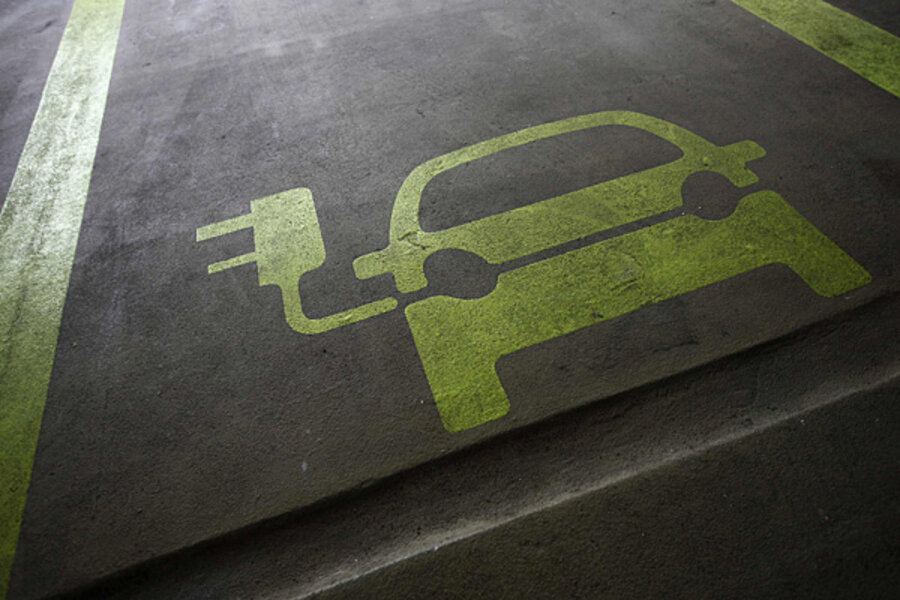How 'smart parking' could save a million barrels of oil every day
Loading...
Searching for a parking space is a routine (and often frustrating) activity for many people in cities around the world. This search burns about one million barrels of the world’s oil every day. There are also four parking spaces per vehicle in the United States, and most streets are empty most of the time, leading to urban environments that ironically do far more to accommodate vehicles than people. As the global population continues to urbanize, without a well-planned, convenience-driven retreat from the car these problems will worsen.
Smart parking is the first step in the right direction. It involves using low-cost sensors, real-time data collection, and mobile-phone-enabled automated payment systems that allow people to reserve parking in advance or very accurately predict where they will likely find a spot. When deployed as a system, smart parking thus reduces car emissions in urban centers by reducing the need for people to needlessly circle city blocks searching for parking. It also permits cities to carefully manage their parking supply.
Smart parking pilot programs are now being deployed in San Francisco, Los Angeles, Stockholm, Beijing, Shanghai, São Paulo, and the Netherlands. For example, in Los Angeles, low-power sensors and smart meters track the occupancy of parking spaces throughout the Hollywood district, one of its most congested areas. Users can access that occupancy data to determine the availability of spots and then pay for them with their mobile phones. In addition to lending convenience and environmental benefits, smart parking improves the utilization of existing parking, leading to greater revenue for parking owners. Los Angeles saw a return on its investment in smart parking within three months.
These programs can make differences on a neighborhood level, but far more widespread deployment and development is needed for smart parking to change cities and to significantly contribute to transportation-sector greenhouse gas and pollution reductions.
One problem is there are no citywide solutions across fragmented public and private parking providers. Occupancy data, if it exists, tends to have many owners and is not standardized or accessible in a way that would allow software developers to turn it into user-friendly applications. Thus, individual smart parking efforts so far have been locally successful but uncoordinated, operating in their own bureaucratic or entrepreneurial vacuums without taking advantage of universally-applicable insights to scale their operations citywide or globally. The gap between existing smart parking programs and more widespread transportation system planning is, at the global scale, a massive missed opportunity for cities to reduce transportation-related emissions.
In addition to the challenges associated with multiple data owners and lack of standardization, smart parking solutions have been hindered by a lack of insight into the full benefits of smart parking programs, particularly when compared to the cost of building additional parking spaces. Lack of collaboration among communities with smart parking pilot programs and lack of coordination among software developers, hardware providers, and municipalities also contribute to slower adoption of smart parking.
However, it is possible to overcome all of these issues. The costs of sensors and hardware-based solutions is decreasing drastically, for the first time allowing cities and companies to gather detailed new data on transportation patterns. Furthermore, with smart phones capturing more and more of the global telecommunications market in both developing and developed nations, software entrepreneurs are able to collect and analyze data and deliver insights and information to consumers in brand new ways that do not require installation of new hardware.
For example, Roadify started in 2009 as a free app that helped New York City residents find parking spaces. Users enter the address of a spot that they are about to leave or of an open spot that they happen to walk by, earning points known as Street Carma (users can later cash in that Carma to redeem rewards). Other users nearby will see that spot on the app if they search the area. The app has since expanded to cities nationwide and now provides real-time transit information about schedules, delays, accidents, and more from crowd-sourced commentary about local transit conditions.
The system benefits of smart parking go well beyond avoiding the needless circling of city blocks. It also enables cities to develop fully integrated multimodal intelligent transportation systems that don’t rely on cars in the first place. Developing smart parking solutions within a city requires data standardization and management; mobile phone integration; hardware and software innovation; and coordination among various stakeholders (on and off street parking facility owners, business owners, municipalities, transportation authorities, customers, and software developers). These technical solutions and stakeholders are the same data structures and development groups integral to making a smartphone-enabled, multimodal, fully integrated transportation solution a reality. In effect, the technical enablers and multi-stakeholder coordination effort behind development of a local smart parking solution creates a launchpad toward full transportation system integration.
Finally, in the long run smart parking can actually transform the very makeup of our urban landscapes, making them more amenable to people rather than cars. With the advent of smart parking and more mobility alternatives to personal vehicles, better use of existing parking will drive decreased demand for the country’s 4:1 parking space surplus, opening up opportunities for parking garage reuse and, for surface parking, “infill urban development”—building on or re-greening the land to create or expand living space, businesses, and recreational areas in cities. Cities can further accelerate these benefits by updating building codes and land use policies to reflect reduced need for parking—a move which drives down building costs and encourages more varied development options. In the end, urban spaces can become greener; cleaner; more compact; and more inherently walkable, bikeable, and serviceable by a multimodal transportation system.







